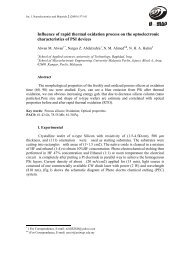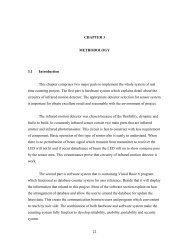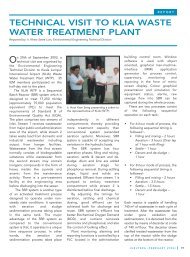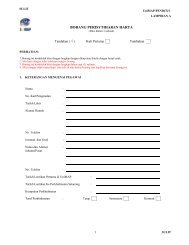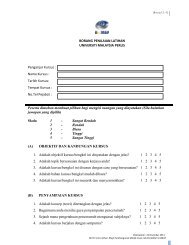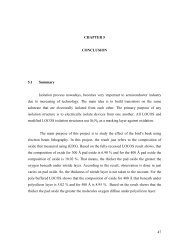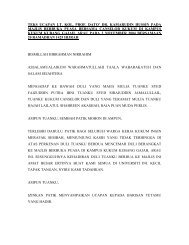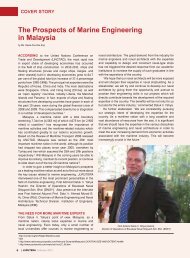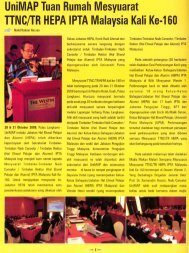Network Fabrics for the Modern Data Center - UniMAP
Network Fabrics for the Modern Data Center - UniMAP
Network Fabrics for the Modern Data Center - UniMAP
You also want an ePaper? Increase the reach of your titles
YUMPU automatically turns print PDFs into web optimized ePapers that Google loves.
NETWORK FABRICS FOR THE<br />
MODERN DATA CENTER<br />
New <strong>Data</strong> <strong>Center</strong>s Require a New <strong>Network</strong><br />
WHITE PAPER<br />
Copyright © 2010, Juniper <strong>Network</strong>s, Inc. 1
WHITE PAPER - <strong>Data</strong> <strong>Center</strong> Fabric <strong>for</strong> Cloud <strong>Network</strong>s<br />
Table of Contents<br />
Executive Summary . . . . . . . . . . . . . . . . . . . . . . . . . . . . . . . . . . . . . . . . . . . . . . . . . . . . . . . . . . . . . . . . . . . . . . . . . . . . . . . . . . . . . . . . . . . . . . . . . . . . . . . . 3<br />
Introduction . . . . . . . . . . . . . . . . . . . . . . . . . . . . . . . . . . . . . . . . . . . . . . . . . . . . . . . . . . . . . . . . . . . . . . . . . . . . . . . . . . . . . . . . . . . . . . . . . . . . . . . . . . . . . . . . 3<br />
The <strong>Modern</strong> <strong>Data</strong> <strong>Center</strong> . . . . . . . . . . . . . . . . . . . . . . . . . . . . . . . . . . . . . . . . . . . . . . . . . . . . . . . . . . . . . . . . . . . . . . . . . . . . . . . . . . . . . . . . . . . . . . . . . . . . 3<br />
Old Architecture Can’t Support <strong>the</strong> New Requirements . . . . . . . . . . . . . . . . . . . . . . . . . . . . . . . . . . . . . . . . . . . . . . . . . . . . . . . . . . . . . . . . . . . 4<br />
New Traffic Patterns Drive New <strong>Network</strong> Designs . . . . . . . . . . . . . . . . . . . . . . . . . . . . . . . . . . . . . . . . . . . . . . . . . . . . . . . . . . . . . . . . . . . . . . . . . 5<br />
Three Classes of Traffic in <strong>the</strong> <strong>Data</strong> <strong>Center</strong> . . . . . . . . . . . . . . . . . . . . . . . . . . . . . . . . . . . . . . . . . . . . . . . . . . . . . . . . . . . . . . . . . . . . . . . . . . . . . . 6<br />
Ma<strong>the</strong>matics of Complexity . . . . . . . . . . . . . . . . . . . . . . . . . . . . . . . . . . . . . . . . . . . . . . . . . . . . . . . . . . . . . . . . . . . . . . . . . . . . . . . . . . . . . . . . . . . . . . 6<br />
The New <strong>Network</strong> Requirements . . . . . . . . . . . . . . . . . . . . . . . . . . . . . . . . . . . . . . . . . . . . . . . . . . . . . . . . . . . . . . . . . . . . . . . . . . . . . . . . . . . . . . . . . . . . 8<br />
Simplification . . . . . . . . . . . . . . . . . . . . . . . . . . . . . . . . . . . . . . . . . . . . . . . . . . . . . . . . . . . . . . . . . . . . . . . . . . . . . . . . . . . . . . . . . . . . . . . . . . . . . . . . . . . 8<br />
Lowest Possible Latency, Highest Possible Bandwidth, Lowest Possible Congestion . . . . . . . . . . . . . . . . . . . . . . . . . . . . . . . . . . . . . . 8<br />
The New <strong>Network</strong> Requires a Scalable <strong>Network</strong> Fabric. . . . . . . . . . . . . . . . . . . . . . . . . . . . . . . . . . . . . . . . . . . . . . . . . . . . . . . . . . . . . . . . . . . . 9<br />
Juniper Delivers Fabric <strong>for</strong> <strong>Network</strong>s . . . . . . . . . . . . . . . . . . . . . . . . . . . . . . . . . . . . . . . . . . . . . . . . . . . . . . . . . . . . . . . . . . . . . . . . . . . . . . . . . . . . . . . . . 9<br />
Extending <strong>Fabrics</strong> Across <strong>Data</strong> <strong>Center</strong>s . . . . . . . . . . . . . . . . . . . . . . . . . . . . . . . . . . . . . . . . . . . . . . . . . . . . . . . . . . . . . . . . . . . . . . . . . . . . . . . . . . . 9<br />
Single Operating System, Single Orchestration Plat<strong>for</strong>m . . . . . . . . . . . . . . . . . . . . . . . . . . . . . . . . . . . . . . . . . . . . . . . . . . . . . . . . . . . . . . . . . 12<br />
Conclusion . . . . . . . . . . . . . . . . . . . . . . . . . . . . . . . . . . . . . . . . . . . . . . . . . . . . . . . . . . . . . . . . . . . . . . . . . . . . . . . . . . . . . . . . . . . . . . . . . . . . . . . . . . . . . . . . 12<br />
About Juniper <strong>Network</strong>s . . . . . . . . . . . . . . . . . . . . . . . . . . . . . . . . . . . . . . . . . . . . . . . . . . . . . . . . . . . . . . . . . . . . . . . . . . . . . . . . . . . . . . . . . . . . . . . . . . . 12<br />
Table of Figures<br />
Figure 1: Legacy tree structures impose varying levels of delay when delivering<br />
packets across <strong>the</strong> network. . . . . . . . . . . . . . . . . . . . . . . . . . . . . . . . . . . . . . . . . . . . . . . . . . . . . . . . . . . . . . . . . . . . . . . . . . . . . . . . . . . . . . . . 5<br />
Figure 2: The number of potential interactions grows disproportionately with each new managed device. . . . . . . . . . . . . . . . . . . . 7<br />
Figure 3: Traditional multitier data center network environment . . . . . . . . . . . . . . . . . . . . . . . . . . . . . . . . . . . . . . . . . . . . . . . . . . . . . . . . . . . . . 7<br />
Figure 4: Juniper solutions deployed as a fabric dramatically simplify <strong>the</strong> data center network, reducing <strong>the</strong><br />
number of devices, improving per<strong>for</strong>mance, and reducing costs. . . . . . . . . . . . . . . . . . . . . . . . . . . . . . . . . . . . . . . . . . . . . . . . . . . 10<br />
Figure 5: Virtual Chassis technology reduces complexity associated with interactions between disparate<br />
switches in <strong>the</strong> data center network. . . . . . . . . . . . . . . . . . . . . . . . . . . . . . . . . . . . . . . . . . . . . . . . . . . . . . . . . . . . . . . . . . . . . . . . . . . . . . . 11<br />
Figure 6: Juniper <strong>Network</strong>s’ vision <strong>for</strong> <strong>the</strong> ultimate simplification of <strong>the</strong> data center is Project Stratus,<br />
which will deliver a single fabric that unites E<strong>the</strong>rnet, Fibre Channel, and Infiniband networks. . . . . . . . . . . . . . . . . . . . . . 11<br />
2 Copyright © 2010, Juniper <strong>Network</strong>s, Inc.
Executive Summary<br />
WHITE PAPER - <strong>Data</strong> <strong>Center</strong> Fabric <strong>for</strong> Cloud <strong>Network</strong>s<br />
It has been almost 50 years since computers combined with networks to create <strong>the</strong> first online transaction processing<br />
system. This development ushered in <strong>the</strong> modern data center, where local processing and storage came toge<strong>the</strong>r with<br />
network-connected users. In a very real sense, <strong>the</strong> network created today’s data center; now, in an ironic twist, modern data<br />
centers require a new network, one that can help drive <strong>the</strong> data center into a new era.<br />
This paper is intended <strong>for</strong> technical decision makers who are interested in understanding Juniper’s vision of how to evolve<br />
<strong>the</strong> data center. It examines <strong>the</strong> changes occurring in <strong>the</strong> data center and how <strong>the</strong>se changes mandate a different design<br />
approach. This paper explains Juniper’s approach to building data centers using fabrics and how this will evolve to meet <strong>the</strong><br />
increasing challenges of scale and complexity. The reader will learn about Juniper’s current fabric solution <strong>for</strong> data centers<br />
and get a view of our vision <strong>for</strong> future evolution.<br />
Introduction<br />
Draw <strong>the</strong> network of <strong>the</strong> past and you’ll see a complicated hierarchy of switches—essentially<br />
a tree. Now draw <strong>the</strong> network of <strong>the</strong> future and you’ll see a fabric—a simple, flat tapestry that<br />
unites all network elements as a single, logical entity.<br />
As business requirements drive in<strong>for</strong>mation technology in new directions, <strong>the</strong> network is defining <strong>the</strong> data center of <strong>the</strong><br />
future. The early mission of providing user access to applications remains, but modern networks are also connecting systems<br />
and even data centers to create cloud computing infrastructures that share a common set of global processing, storage, and<br />
application resources. Storage networking is exploding as enterprises look to consolidate <strong>the</strong>ir storage environments with<br />
<strong>the</strong>ir data center networks. Interprocess communications (IPC), <strong>the</strong> glue that binds service-oriented architectures (SOA), is<br />
also growing as a network application, to <strong>the</strong> point where it rivals user connectivity.<br />
<strong>Network</strong>s and data centers are entering into a new, tighter, and more exciting partnership.<br />
Traffic, once bidirectional, is now omnidirectional.<br />
Enterprise sensitivity to delay and packet loss, once confined to a few vertical markets, is spreading horizontally to all sectors.<br />
Virtualization, cloud computing, SOA, and <strong>the</strong> ever expanding operational demands <strong>for</strong> improved productivity through<br />
in<strong>for</strong>mation technology are all driving <strong>the</strong> data center into a new era. Applications, in<strong>for</strong>mation, storage, processing, and<br />
networking are now equally important elements in <strong>the</strong> data center, and each must evolve to optimize and support <strong>the</strong> o<strong>the</strong>rs.<br />
New requirements create new demands, and new network capabilities open avenues <strong>for</strong> improvement in IT process costs<br />
and efficiencies.<br />
Juniper <strong>Network</strong>s ® was founded on <strong>the</strong> principle that <strong>the</strong> Internet changed everything. <strong>Network</strong>s must be built in a<br />
fundamentally different way to meet <strong>the</strong> evolving needs of <strong>the</strong> Internet. Toward that end, Juniper <strong>Network</strong>s has introduced<br />
a new “3-2-1” data center network architecture based on innovative fabric technology that enables multiple interconnected<br />
networking devices to behave as a single logical device. This fabric technology dramatically reduces complexity and<br />
consolidates <strong>the</strong> data center network from 3 layers to 2, moving eventually to a single layer.<br />
The <strong>Modern</strong> <strong>Data</strong> <strong>Center</strong><br />
The modern data center has undergone a series of changes that have significantly impacted business operations.<br />
First, <strong>the</strong> advent of service-oriented architectures—a method of structuring applications as a series of connected<br />
components that can be distributed and run on multiple servers, or assembled in different ways to efficiently share<br />
workload—<strong>for</strong>ever changed traffic patterns within <strong>the</strong> data center. While SOA turned what were once fairly monolithic<br />
applications into a set of highly agile, flexible, and scalable services, it also dramatically increased <strong>the</strong> number of servers.<br />
This overprovisioning of servers led to a dramatic underutilization of <strong>the</strong>se critical—and expensive—resources; in fact,<br />
according to some CIO estimates, 60 to 80 percent of an enterprise’s total computing power is wasted due to underutilized<br />
server capacity.<br />
Copyright © 2010, Juniper <strong>Network</strong>s, Inc. 3
WHITE PAPER - <strong>Data</strong> <strong>Center</strong> Fabric <strong>for</strong> Cloud <strong>Network</strong>s<br />
To address this underutilization, <strong>the</strong> concepts of virtualization (which defines <strong>the</strong> hardware and software needed to host<br />
an application as a logical machine image that can <strong>the</strong>n be allocated to one of many compatible physical servers in a<br />
data center) and cloud computing (an extension of virtualization principles that weaves data centers into large pools of<br />
dynamically shared resources) were introduced.<br />
With virtualization and cloud computing, which introduced new “server-to-server” or “server-to-storage” (referred to as<br />
“east-west”) traffic flows into <strong>the</strong> data center, existing servers could be logically grouped into a single, large pool of available<br />
resources. Aggregating <strong>the</strong> capacity of <strong>the</strong>se devices into a single pool of available storage enabled much more efficient<br />
utilization—so much so that <strong>the</strong> total number of servers could be reduced dramatically without impacting per<strong>for</strong>mance—<br />
resulting in a related reduction in both capital and operational expenses.<br />
Old Architecture Can’t Support <strong>the</strong> New Requirements<br />
Un<strong>for</strong>tunately, networking technology hasn’t kept pace with <strong>the</strong> o<strong>the</strong>r innovations in <strong>the</strong> data center. LAN technology, and<br />
E<strong>the</strong>rnet in particular, have traditionally provided <strong>the</strong> connectivity required to support <strong>the</strong> growing number of applications<br />
used in business operations. However, E<strong>the</strong>rnet switches don’t have an infinite number of ports or infinite backplane capacity;<br />
<strong>the</strong>re<strong>for</strong>e, to accommodate universal connectivity and growth, enterprises were <strong>for</strong>ced to build hierarchical “tree structure”<br />
data center networks with switches arranged in layers to provide <strong>the</strong> necessary port densities, creating a “north-south” traffic<br />
pattern. Traffic between ports in <strong>the</strong> same rack could be carried by a single switch, but as <strong>the</strong> number of racks grew, more<br />
switching layers were involved in every transaction.<br />
This network model has a distinct deficiency: <strong>the</strong> need <strong>for</strong> multiple switch transits to achieve universal connectivity. Every<br />
time a data packet <strong>for</strong> an application passes through a switch, it must be read in, decoded and routed, <strong>the</strong>n written out. Each<br />
such passage imposes additional latency and subjects <strong>the</strong> data packet to random collisions with o<strong>the</strong>r traffic that can cause<br />
even more delays or even packet loss. <strong>Network</strong> architects have sought to limit <strong>the</strong>se problems by ensuring that <strong>the</strong> output<br />
connections <strong>for</strong> switches—<strong>the</strong> “trunk”—were ten times <strong>the</strong> speed of <strong>the</strong> port or input connections. That favorable output ratio<br />
was maintained by closely monitoring utilization and adding additional capacity when traffic levels crossed <strong>the</strong> 30% threshold.<br />
Higher utilization increased <strong>the</strong> risk of collisions, which in turn increased latency, delay variability or jitter, and dropped packets.<br />
The risk of per<strong>for</strong>mance problems multiply with each switch transit and with each layer of <strong>the</strong> switch hierarchy.<br />
Multiple layers also increase network and traffic management requirements. Since network per<strong>for</strong>mance varies considerably<br />
depending on where traffic originates and terminates, it becomes more important—and more difficult—to group ports that<br />
frequently communicate with one ano<strong>the</strong>r on <strong>the</strong> same or on nearby switches. Traffic management also becomes more<br />
difficult; as <strong>the</strong> number of layers grows, it becomes increasingly difficult to maintain <strong>the</strong> 10:1 uplink vs. downlink speed ratio,<br />
which in turn makes it difficult to engineer <strong>the</strong> network so that it per<strong>for</strong>ms consistently under varying loads.<br />
Figure 1 illustrates this problem. In a typical three-layer switch hierarchy used in some large data centers, traffic between any<br />
two switch ports can pass through a varying number of switches, depending on which two ports are involved. If two switches<br />
have <strong>the</strong> same “parent” in <strong>the</strong> hierarchy, <strong>the</strong>n only three switches are involved in <strong>the</strong> connection. As <strong>the</strong> two ports become<br />
more separated, however, <strong>the</strong> number of switches grows. Each increase in <strong>the</strong> number of transits adds to <strong>the</strong> total and<br />
potential delay, not to mention adding <strong>the</strong> risk of congestion and packet loss. In o<strong>the</strong>r words, in a tree hierarchy, packets must<br />
first travel north-south be<strong>for</strong>e <strong>the</strong>y can move east-west—a highly inefficient model.<br />
4 Copyright © 2010, Juniper <strong>Network</strong>s, Inc.
WHITE PAPER - <strong>Data</strong> <strong>Center</strong> Fabric <strong>for</strong> Cloud <strong>Network</strong>s<br />
Figure 1: Legacy tree structures impose varying levels of delay when delivering<br />
packets across <strong>the</strong> network.<br />
The evolution of <strong>the</strong> data center network has largely been driven by <strong>the</strong> data center’s mission, which is connecting users<br />
to applications. While this mission is essentially responsible <strong>for</strong> <strong>the</strong> current hierarchy-of-switches architecture, it has also<br />
helped hide that architecture’s deficiencies. That’s because user-to-application traffic is normally low speed and tolerant of<br />
both delay and packet loss; modern protocols recover well from dropped packets, and user “think time” often camouflages<br />
network delays. In o<strong>the</strong>r words, as long as traffic tolerates “best-ef<strong>for</strong>t” service, <strong>the</strong> old hierarchical switch architecture works.<br />
However, some vertical markets such as finance are now suffering from <strong>the</strong> limitations of <strong>the</strong> multilayer switch hierarchies.<br />
Trading systems are <strong>the</strong> most demanding of all modern IT applications; <strong>the</strong>y—and o<strong>the</strong>r SOA-based applications—will not<br />
tolerate delay or packet loss because a dropped packet or tardy transaction could cost thousands of dollars, <strong>for</strong> <strong>the</strong>mselves<br />
and <strong>for</strong> <strong>the</strong>ir customers.<br />
New Traffic Patterns Drive New <strong>Network</strong> Designs<br />
SOAs, virtualization, and cloud computing have had such an impact on data center traffic patterns that today, approximately<br />
75% of it can be characterized as east-west. In order to optimize <strong>the</strong> per<strong>for</strong>mance of data center traffic, <strong>the</strong> traditional tree<br />
structure must be abandoned in favor of an any-to-any storage/server mesh that can eliminate <strong>the</strong> need <strong>for</strong> traffic to travel<br />
north-south be<strong>for</strong>e it can flow east-west.<br />
While most enterprises still use specialized storage switches like Fiber Channel to link servers with storage devices, <strong>the</strong>re is<br />
growing interest in consolidating storage networks with <strong>the</strong> rest of <strong>the</strong> data center network to realize efficiencies of scale and<br />
reduce <strong>the</strong> number of siloed networks that need to be maintained and managed. The current trends toward virtualization<br />
and cloud computing are likely to accelerate this shift, and this means that storage traffic will be added to user/application<br />
traffic in <strong>the</strong> data center.<br />
Copyright © 2010, Juniper <strong>Network</strong>s, Inc. 5
WHITE PAPER - <strong>Data</strong> <strong>Center</strong> Fabric <strong>for</strong> Cloud <strong>Network</strong>s<br />
Application components and pool resource management processes also need to be connected in order to coordinate <strong>the</strong>ir<br />
interactions. This type of traffic is “invisible” to <strong>the</strong> user in that it’s not something client systems and <strong>the</strong>ir users are directly<br />
involved with. However, <strong>the</strong> way this traffic is handled may be a major factor in <strong>the</strong> user’s experience with key applications,<br />
which means it can impact productivity.<br />
Three Classes of Traffic in <strong>the</strong> <strong>Data</strong> <strong>Center</strong><br />
Three types of traffic classes—groups of applications with similar service quality and availability requirements—are typically<br />
found in today’s data center. The first is <strong>the</strong> original user/application traffic, and it is still growing. The second type, storage<br />
traffic, is exploding as networked storage use grows. The third type, interprocess communications (IPC) traffic, is driven by<br />
SOA componentization and resource pool management <strong>for</strong> virtualization and cloud computing.<br />
Each of <strong>the</strong>se three traffic classes has varying degrees of tolerance <strong>for</strong> delay, delay variability (jitter), and packet loss.<br />
Businesses are increasingly employing all three types of traffic in applications like business intelligence and data mining to help<br />
<strong>the</strong>m make intelligent, in<strong>for</strong>med decisions. These applications often require analysis of large amounts of data, and if this data<br />
handling is impacted by packet loss and delay, <strong>the</strong> transactions can take so long as to make <strong>the</strong>m useless to decision makers.<br />
Ma<strong>the</strong>matics of Complexity<br />
The variability of potential traffic paths, combined with <strong>the</strong> multiplicity of traffic classes, poses significant challenges<br />
<strong>for</strong> network operations with respect to planning and managing hierarchical data center networks. Generally speaking,<br />
network complexity grows disproportionately as <strong>the</strong> number of devices in <strong>the</strong> network increases, so deep hierarchies create<br />
bewildering complexity levels very quickly<br />
The complexity in managing <strong>the</strong> network is not just a function of <strong>the</strong> number of devices to be managed, but also of <strong>the</strong><br />
number of device interactions between those devices. There is an accelerating increase in <strong>the</strong> number of interactions that<br />
occur between switches as a network grows, making it necessary to not only manage <strong>the</strong> switches in <strong>the</strong> network, but also to<br />
manage <strong>the</strong> number of interactions between those switches.<br />
<strong>Network</strong>ing protocols like Spanning Tree Protocol (STP), link aggregation groups (LAGs), routing, and security rely on<br />
effective interactions between switches, and <strong>the</strong>se grow more numerous with each added device. This can be expressed in<br />
<strong>the</strong> following <strong>for</strong>mula, where i is <strong>the</strong> number of potential user configured interactions, and n is <strong>the</strong> number of devices.<br />
For example, 10 switches can generate 45 interactions. With 100 switches, however, <strong>the</strong> number of potential interactions<br />
grows to nearly 4,950, while 1,000 switches can produce a possible upper limit of 499,500 interactions.<br />
The best way to address complexity, <strong>the</strong>re<strong>for</strong>e, is to reduce or even eliminate <strong>the</strong> number of interactions altoge<strong>the</strong>r by<br />
getting <strong>the</strong> data center network to behave as a single device. In o<strong>the</strong>r words, <strong>the</strong> goal is to reduce n to 1, with no interactions<br />
between devices.<br />
6 Copyright © 2010, Juniper <strong>Network</strong>s, Inc.
Complexity<br />
Devices<br />
400<br />
300<br />
200<br />
100<br />
0<br />
Interactions<br />
10,000<br />
7,500<br />
5,000<br />
2,500<br />
1,000 2,000 3,000 4,000<br />
Number of Ports<br />
WHITE PAPER - <strong>Data</strong> <strong>Center</strong> Fabric <strong>for</strong> Cloud <strong>Network</strong>s<br />
Figure 2: The number of potential interactions grows disproportionately with each new managed device.<br />
E<strong>the</strong>rnet<br />
Solve <strong>for</strong> <strong>the</strong> smallest N possible<br />
No. of Interactions =<br />
Nx(N-1)<br />
2<br />
N = No. of managed devices<br />
Figure 3: Traditional multitier data center network environment<br />
Too Complex<br />
Interactions<br />
Managed<br />
Devices<br />
5,000 6,000<br />
3 2 1 The legacy network, 3 tiers.<br />
Servers NAS FC<br />
Storage<br />
FC SAN<br />
Copyright © 2010, Juniper <strong>Network</strong>s, Inc. 7
WHITE PAPER - <strong>Data</strong> <strong>Center</strong> Fabric <strong>for</strong> Cloud <strong>Network</strong>s<br />
The New <strong>Network</strong> Requirements<br />
Simplification<br />
Enterprises report that errors and problems related to application setup, device changes, scheduled maintenance, and failure<br />
response account <strong>for</strong> as much as one-third of application downtime. Manual provisioning of data center networks is growing<br />
impossibly complex, but <strong>the</strong> tools used to automate <strong>the</strong> provisioning process are <strong>the</strong>mselves subject to errors—caused by<br />
<strong>the</strong> very network complexity <strong>the</strong>se tools are designed to support. It’s virtually impossible to <strong>for</strong>esee all of <strong>the</strong> possible failure<br />
modes of a three- or four-tier network structure, and to assess how traffic flows in each switch might impact packet delay<br />
and loss. Complexity threatens to make <strong>the</strong> management of application per<strong>for</strong>mance a guessing game.<br />
Virtualization and cloud computing are placing even greater demands on today’s data center network. To be truly effective,<br />
<strong>the</strong>se high-per<strong>for</strong>mance technologies demand <strong>the</strong> lowest possible network latency and number of packets. There<strong>for</strong>e, <strong>the</strong><br />
data center network must evolve to meet <strong>the</strong>se new requirements or risk becoming part of <strong>the</strong> problem ra<strong>the</strong>r than part of<br />
<strong>the</strong> solution.<br />
Lowest Possible Latency, Highest Possible Bandwidth, Lowest Possible Congestion<br />
No matter how good or how fast an individual data center switch may be, a multitiered hierarchical collection of those<br />
switches will impose complexity and per<strong>for</strong>mance problems.<br />
The logical solution to <strong>the</strong> data center switching problem is to achieve <strong>the</strong> concept of<br />
“universal connectivity” more directly, without introducing a deep switch hierarchy.<br />
This approach, called “flattening” <strong>the</strong> network, reduces <strong>the</strong> number of layers and weaves <strong>the</strong> remaining components into a<br />
common “fabric” that provides any port with dependable, high capacity connectivity to any o<strong>the</strong>r port, from any location.<br />
Such a fabric technology enables multiple networking devices such as switches to be operated and managed as a single,<br />
logical device. By fundamentally reducing <strong>the</strong> number of networked devices to manage, fabric technologies dramatically<br />
reduce <strong>the</strong> cost and complexity associated with large data center networks, while improving per<strong>for</strong>mance and efficiency.<br />
By reducing switching layers, a fabric will also reduce <strong>the</strong> number of switches that traffic has to pass through, eliminating <strong>the</strong><br />
primary sources of delay and packet loss present in today’s hierarchical networks. This is <strong>the</strong> single most important step an<br />
enterprise can take to improve network per<strong>for</strong>mance.<br />
Since a fabric is also managed and provisioned as a single device, it vastly reduces <strong>the</strong> operational complexity of <strong>the</strong><br />
data center network, accelerates application and user provisioning, and reduces common errors associated with switch<br />
configuration management that can impact application availability.<br />
8 Copyright © 2010, Juniper <strong>Network</strong>s, Inc.
The New <strong>Network</strong> Requires a Scalable <strong>Network</strong> Fabric<br />
What is a <strong>Network</strong> Fabric?<br />
WHITE PAPER - <strong>Data</strong> <strong>Center</strong> Fabric <strong>for</strong> Cloud <strong>Network</strong>s<br />
Creating a common network fabric requires interconnecting <strong>the</strong> individual, independent devices that currently populate<br />
<strong>the</strong> data center so that <strong>the</strong>y “collectively emulate” <strong>the</strong> behavior of a single, logical device that reflects <strong>the</strong> following<br />
characteristics:<br />
a) Any-to-any connectivity: A true fabric must provide a direct connection between any two ports.<br />
b) Flat: A fabric must support single step/lookup-based processing.<br />
c) Simplified management: A fabric must present itself as a single entity with a single point of management.<br />
d) Single, consistent state: Regardless of its various components, a fabric must appear on <strong>the</strong> outside as a single,<br />
logical device with a single, consistent state.<br />
The fabric concept is nothing new; switches have always had a fabric in <strong>the</strong> <strong>for</strong>m of a backplane that connects all of <strong>the</strong><br />
ports on <strong>the</strong> switch. The key is to extend that per-switch fabric to achieve full connectivity, deterministic per<strong>for</strong>mance, and<br />
unified operations throughout <strong>the</strong> entire data center. To accomplish this, it is essential that <strong>the</strong> devices that comprise a fabric<br />
behave more like a single logical device than a set of switches connected in <strong>the</strong> traditional hierarchical model.<br />
Juniper Delivers Fabric <strong>for</strong> <strong>Network</strong>s<br />
Juniper <strong>Network</strong>s has developed a comprehensive data center fabric strategy that achieves this goal—a blueprint <strong>for</strong> success<br />
that has helped some of <strong>the</strong> world’s most demanding data centers reduce complexity by eliminating switch layers, lowering<br />
power consumption, and minimizing up-front investments. Juniper’s fabric technology fundamentally changes <strong>the</strong> dynamics of<br />
networking in <strong>the</strong> data center, leading <strong>the</strong> evolution to a virtualized cloud computing-dominated framework <strong>for</strong> <strong>the</strong> enterprise.<br />
In fact, Juniper has been delivering products based on network fabric technology <strong>for</strong> more than five years. The Juniper <strong>Network</strong>s<br />
TX Matrix Plus family, <strong>for</strong> instance, supports network fabrics composed of up to 16 interconnected Juniper <strong>Network</strong>s T Series<br />
Core Routers. Two years ago, Juniper extended <strong>the</strong> same fabric concept to its Juniper <strong>Network</strong>s EX Series E<strong>the</strong>rnet Switches<br />
with Virtual Chassis technology, allowing up to 10 Juniper <strong>Network</strong>s EX4200 E<strong>the</strong>rnet Switches to be interconnected over a<br />
128 Gbps backplane to create a single, logical device. Both <strong>the</strong> TX Matrix Plus and Virtual Chassis technology provide inter-<br />
device connectivity through an ultrafast backplane extender with orders of magnitude greater capacity than is available with<br />
traditional E<strong>the</strong>rnet switch-to-switch connectivity. These Juniper technologies implement fabrics today that effectively reduce<br />
<strong>the</strong> number of layers by allowing more interconnectivity per layer. Latency and packet loss are reduced, and <strong>the</strong> high inter-<br />
switch capacity makes it much easier to manage traffic by reducing inter-switch trunk utilization.<br />
Extending <strong>Fabrics</strong> Across <strong>Data</strong> <strong>Center</strong>s<br />
Juniper solutions deployed as a fabric can flatten a data center network while improving per<strong>for</strong>mance and lowering costs. In<br />
this example (Figure 4), a typically complex multitier switching hierarchy <strong>for</strong> a data center has been replaced by a flattened<br />
and simplified fabric based on a combination of Juniper <strong>Network</strong>s MX Series 3D Universal Edge Routers and EX Series<br />
switches, dramatically reducing <strong>the</strong> number of devices and simplifying overall network maintenance.<br />
Copyright © 2010, Juniper <strong>Network</strong>s, Inc. 9
WHITE PAPER - <strong>Data</strong> <strong>Center</strong> Fabric <strong>for</strong> Cloud <strong>Network</strong>s<br />
SRX5800<br />
Figure 4: Juniper solutions deployed as a fabric dramatically simplify <strong>the</strong> data center network, reducing<br />
<strong>the</strong> number of devices, improving per<strong>for</strong>mance, and reducing costs.<br />
Inside <strong>the</strong>se Virtual Chassis configurations, <strong>the</strong> connectivity map is maintained without <strong>the</strong> need <strong>for</strong> STP, and all three<br />
classes of traffic introduced earlier—user/application traffic, storage traffic, and interprocess communications (IPC) traffic—can<br />
be carried simultaneously with per<strong>for</strong>mance guarantees based on <strong>the</strong>ir respective sensitivity to loss and delay. In addition,<br />
backup failover routes can be established to ensure that all traffic classes have connectivity during maintenance, upgrades,<br />
device diagnosis and redeployments, and network failures.<br />
In <strong>the</strong> example shown here, a change from a three-tier to a two-tier hierarchy reduces <strong>the</strong> worst case path from five switch<br />
transits to three. If four switch tiers were collapsed onto two, <strong>the</strong> worst case path would be reduced from seven transits to<br />
three—less than half <strong>the</strong> original number.<br />
Servers<br />
3 2 1 Today, move to 2 tiers.<br />
MX Series<br />
EX8216<br />
Storage<br />
NAS FC<br />
Storage<br />
FC SAN<br />
EX4200<br />
10 Copyright © 2010, Juniper <strong>Network</strong>s, Inc.
WHITE PAPER - <strong>Data</strong> <strong>Center</strong> Fabric <strong>for</strong> Cloud <strong>Network</strong>s<br />
Figure 5 illustrates how a fabric based on Juniper’s Virtual Chassis technology can fundamentally reduce complexity in <strong>the</strong><br />
data center.<br />
Complexity<br />
Devices<br />
400<br />
300<br />
200<br />
100<br />
0<br />
1,000 2,000 3,000 4,000<br />
Figure 5: Virtual Chassis technology reduces complexity associated with interactions<br />
between disparate switches in <strong>the</strong> data center network.<br />
In <strong>the</strong> near future, Juniper will deliver enhanced fabric technologies that reduce two-layer networks to just one by delivering<br />
a single, logical switch that will provide what evolving data centers need: <strong>the</strong> lowest possible latency, greatest possible<br />
bandwidth, and lowest possible congestion (see Figure 6).<br />
SRX Series<br />
Interactions<br />
10,000<br />
7,500<br />
5,000<br />
2,500<br />
MX Series<br />
At 6,000 ports:<br />
• 89% reduction in managed devices<br />
• 99% reduction in interactions<br />
At 1,000 ports:<br />
• 83% reduction in managed devices<br />
• 97% reduction in interactions<br />
Servers<br />
Number of Ports<br />
Interactions<br />
Managed<br />
Devices<br />
Interactions with Virtual Chassis<br />
5,000 6,000<br />
3 2 1 One tier network fabric tomorrow.<br />
The Stratus Project<br />
NAS FC Storage<br />
Figure 6: Juniper <strong>Network</strong>s’ vision <strong>for</strong> <strong>the</strong> ultimate simplification of <strong>the</strong> data center is Project Stratus,<br />
which will deliver a single fabric that unites E<strong>the</strong>rnet, Fibre Channel, and Infiniband networks.<br />
Copyright © 2010, Juniper <strong>Network</strong>s, Inc. 11
WHITE PAPER - <strong>Data</strong> <strong>Center</strong> Fabric <strong>for</strong> Cloud <strong>Network</strong>s<br />
Corporate and Sales Headquarters<br />
Juniper <strong>Network</strong>s, Inc.<br />
1194 North Mathilda Avenue<br />
Sunnyvale, CA 94089 USA<br />
Phone: 888.JUNIPER (888.586.4737)<br />
or 408.745.2000<br />
Fax: 408.745.2100<br />
www.juniper.net<br />
Copyright 2010 Juniper <strong>Network</strong>s, Inc. All rights reserved. Juniper <strong>Network</strong>s, <strong>the</strong> Juniper <strong>Network</strong>s logo, Junos, NetScreen,<br />
and ScreenOS are registered trademarks of Juniper <strong>Network</strong>s, Inc. in <strong>the</strong> United States and o<strong>the</strong>r countries. Junos is a<br />
trademark of Juniper <strong>Network</strong>s, Inc. All o<strong>the</strong>r trademarks, service marks, registered marks, or registered service marks are<br />
<strong>the</strong> property of <strong>the</strong>ir respective owners. Juniper <strong>Network</strong>s assumes no responsibility <strong>for</strong> any inaccuracies in this document.<br />
Juniper <strong>Network</strong>s reserves <strong>the</strong> right to change, modify, transfer, or o<strong>the</strong>rwise revise this publication without notice.<br />
2000327-002-EN May 2010<br />
Single Operating System, Single Orchestration Plat<strong>for</strong>m<br />
Juniper also provides operations support with its 3-2-1 data center network architecture through <strong>the</strong> integration of its fabric<br />
technologies and its single Juniper <strong>Network</strong>s Junos ® operating system. This support also includes Juniper’s orchestration<br />
model with a new network automation plat<strong>for</strong>m, Juniper <strong>Network</strong>s Junos Space.<br />
Junos Space is open, extensible network automation software that makes it easier to manage and administer <strong>the</strong> data<br />
center by simplifying repetitive and complex tasks, defining and implementing policies within <strong>the</strong> network, and orchestrating<br />
implementation across multiple systems using network-based software. This greatly reduces operational expenses by<br />
reducing configuration errors, measurably improves reliability, and frees up labor resources to innovate ra<strong>the</strong>r than administer.<br />
The Junos Space network application plat<strong>for</strong>m provides end-to-end visibility and control of <strong>the</strong> network to enable network<br />
resources to be orchestrated in response to business needs. Operators can significantly simplify <strong>the</strong> network life cycle,<br />
including configuration, provisioning and troubleshooting with an open, automation plat<strong>for</strong>m.<br />
Junos Space includes a core set of collaborative applications from Juniper and third parties that help managers improve<br />
operational efficiencies, rapidly scale <strong>the</strong>ir infrastructure, and increase <strong>the</strong> reliability and agility of <strong>the</strong>ir network.<br />
Conclusion<br />
The IT world is changing, and that alone will drive mandatory changes in <strong>the</strong> data center. Juniper has invested in fabric<br />
technology innovations and automation tools to address this emerging data center/network dynamic and can meet <strong>the</strong><br />
demanding requirements today and in <strong>the</strong> future with simplicity, per<strong>for</strong>mance, and control.<br />
Juniper’s fabric approach to <strong>the</strong> data center not only addresses <strong>the</strong> structural limitations of hierarchical switching as it relates<br />
to application per<strong>for</strong>mance, but it also dovetails with <strong>the</strong> emerging practices in virtualization and cloud computing—all of<br />
which visualize <strong>the</strong> data center network as a virtual device.<br />
Simplicity delivered by fabric and a 3-2-1 data center network architecture is <strong>the</strong> focus of Juniper’s strategy in <strong>the</strong> data center<br />
network and beyond—a model that begins in <strong>the</strong> data center and enables <strong>the</strong> cloud.<br />
About Juniper <strong>Network</strong>s<br />
Juniper <strong>Network</strong>s, Inc. is <strong>the</strong> leader in high-per<strong>for</strong>mance networking. Juniper offers a high-per<strong>for</strong>mance network infrastructure<br />
that creates a responsive and trusted environment <strong>for</strong> accelerating <strong>the</strong> deployment of services and applications over a single<br />
network. This fuels high-per<strong>for</strong>mance businesses. Additional in<strong>for</strong>mation can be found at www.juniper.net.<br />
APAC Headquarters<br />
Juniper <strong>Network</strong>s (Hong Kong)<br />
26/F, Cityplaza One<br />
1111 King’s Road<br />
Taikoo Shing, Hong Kong<br />
Phone: 852.2332.3636<br />
Fax: 852.2574.7803<br />
EMEA Headquarters<br />
Juniper <strong>Network</strong>s Ireland<br />
Airside Business Park<br />
Swords, County Dublin, Ireland<br />
Phone: 35.31.8903.600<br />
EMEA Sales: 00800.4586.4737<br />
Fax: 35.31.8903.601<br />
To purchase Juniper <strong>Network</strong>s solutions,<br />
please contact your Juniper <strong>Network</strong>s<br />
representative at 1-866-298-6428 or<br />
authorized reseller.<br />
Printed on recycled paper<br />
12 Copyright © 2010, Juniper <strong>Network</strong>s, Inc.



